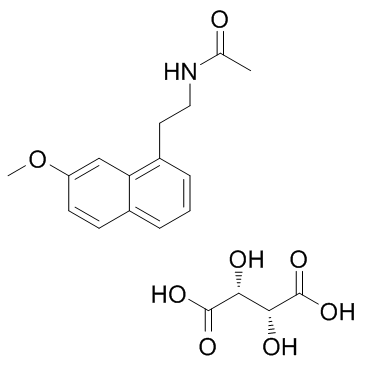Agomelatine L(+)-Tartaric acid |
| Catalog No.GC35270 |
Agomelatine L(+)-Tartaric acid(S-20098 L(+)-Tartaric acid)는 0.1, 0.06, 0.12 및 0.27nM의 Kis를 갖는 MT1 및 MT2 수용체의 특정 작용제입니다. 각각 CHO-hMT2 및 HEK-hMT2.
Products are for research use only. Not for human use. We do not sell to patients.

Cas No.: 824393-18-2
Sample solution is provided at 25 µL, 10mM.
Agomelatine (L(+)-Tartaric acid) is a antidepressant, which is classified as a norepinephrine-dopamine disinhibitor (NDDI) due to its antagonism of the 5-HT2C receptor. Target: 5-HT 2c receptor Agomelatine L(+)-Tartaric acid is an antidepressant drug. It is classified as a norepinephrine-dopamine disinhibitor (NDDI) due to its antagonism of the 5-HT2C receptor. Activation of 5-HT2C receptors by serotonin inhibits dopamine and norepinephrine release. Antagonism of 5-HT2C results in an enhancement of DA and NE release and activity of frontocortical dopaminergic and adrenergic pathways [1]. A total of 42 rats were divided into 7 groups as each composed of 6 rats: (1) intact, (2) 40 mg/kg agomelatine, (3) 140 mg/kg N-acetylcysteine (NAC), (4) 2 g/kg paracetamol, (5) 2 g/kg paracetamol + 140 mg/kg NAC, (6) 2 g/kg paracetamol + 20 mg/kgagomelatine, and (7) 2 g/kg paracetamol + 40 mg/kg agomelatine groups. Paracetamol-induced hepatotoxicity was applied and liver and blood samples were analyzed histopathologically and biochemically. There were statistically significant increases in the activities of aspartate aminotransferase, alanine aminotransferase, levels of tumor necrosis factor-alpha (TNF-α) and interleukin-6 (IL-6) and 8-iso-prostane, and decreases in the activity of superoxide dismutase and level of glutathione in the group treated with paracetamol. Administration of agomelatine and NAC separately reversed these changes significantly [2].Clinical indications: Depression; Obsessive compulsive disorderFDA Approved Date: October 2011Toxicity: Hyperhidrosis; Abdominal pain; Nausea; Vomiting; Diarrhoea; Constipation; Back pain; Fatigue
[1]. Chenu F, et al. Role of melatonin, serotonin 2B, and serotonin 2C receptors in modulating the firing activity of rat dopamine neurons. J Psychopharmacol. 2013 Nov 4. [2]. Karakus E, et al. Agomelatine: an antidepressant with new potent hepatoprotective effects on paracetamol-induced liver damage inrats. Hum Exp Toxicol. 2013 Aug;32(8):846-57.
Average Rating: 5 (Based on Reviews and 8 reference(s) in Google Scholar.)
GLPBIO products are for RESEARCH USE ONLY. Please make sure your review or question is research based.
Required fields are marked with *




















